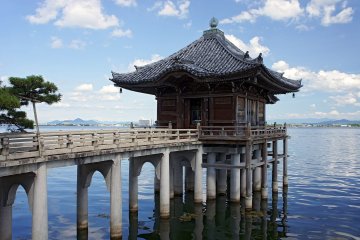Wakasa Town in Fukui Prefecture is located near central Japan, surrounded by the Japanese Alps and Wakasa Bay. It is about one hour and thirty minutes by car from Komatsu Airport, about two hours from Itami Airport, about two hours and thirty minutes from Chubu Centrair International Airport, and about two hours from Kansai International Airport.
Upon arrival, Wakasa Town offers you the chance to unplug from a bustling city and feel the flow of time magically start to slow down. It simultaneously allows you to feel the town’s history while tuning into the beauty of the present moment.
Wakasa Town has an extensive history, with significant ruins and burial mounds dating back to the Jomon period—more than 10,000 years ago! Later, when the Wakasa Highway was built—which connected the Sea of Japan to Kyoto and other parts of the historical Kinai region—Wakasa Town became a hub where many goods and cultures flowed, warmly welcoming travelers along the way. Today, it is a tranquil town filled with kindness and activities that keep its historical beauty alive.
Listed below are highlights of Ms. Kawaguchi, a cabin crew member of Japan Transocean Airways and her experiences in Wakasa Town.
Table of contents
Rainbow Line Summit Park
The Wakasa Bay National Park offers a cable car ride called the Rainbow Line, which takes you to the top of the 400-meter high Baijodake Mountain. At the summit, there is a panoramic view of the breathtaking blue sky and the Five Lakes of Mikata or “Mikata Goko.” The five lakes are Lake Suigetsu, Lake Mikata, Lake Suga, Lake Hiruga, and Lake Kugushi.

There are multiple terraces at the summit where you can relax and admire various viewpoints of the majestic scenery. As a bonus, you can use a free rainbow umbrella—a must-have parasol for a special pop of color.

At Mihama Terrace, you can enjoy a stunning view of all Five Lakes of Mikata while soaking in a relaxing foot bath. This is the only terrace where you can clearly see that each lake is a distinct shade of blue, due to their varying depths and salinities.

You can also relax at a cafe terrace while sipping some Rainbow Blue Tea, a blue herbal tea that turns purple when lemon is added. The cafe also serves a “Saba Katsu Sandwich” featuring thick, grilled mackerel—a specialty of Fukui—sandwiched between two slices of focaccia. This sandwich strikes the perfect balance of salty and crunchy.

Rainbow Line Summit Park is open every day with seasonal hours. The last cable car ride up is thirty minutes before the park closes. Be sure to check their website for specific cafe and shop hours.
Jomon Roman Park
Not only can we appreciate the Five Lakes of Mikata from above, but it is also possible to discover excavated artifacts from the lakes. Jomon Roman Park faces the Five Lakes of Mikata and features a large lawn where events are held, a Jomon-era pit dwelling, and two museums related to the lakes.

The Wakasa Mikata Jomon Museum is dedicated to Jomon culture—one of the most significant prehistoric cultures in Japan. The museum displays artifacts from a village that once stood on the shore of one of the Five Lakes of Mikata. The building’s distinctive exterior resembles the belly of a clay figurine.

Inside the museum, earthenware vessels are lined up in rows in chronological order. The intricate designs and patterns highlight the impressive creativity of the Jomon people.

The permanent exhibition introduces the technology, lifestyle, and culture of the Jomon period. A large wooden boat, excavated from the Yuri Historical Ruins in Wakasa Town, lies beneath the glass floor.

Next to the Wakasa Mikata Jomon Museum is the Fukui Prefectural Varve Museum.

The museum has received numerous architecture-related awards since its opening in 2018. It has recently become the talk of the town after winning the Excellence Award at the 18th Public Architecture Awards.
On the second floor in the main area, there is a stained glass display representing the world's longest varve, which is from Lake Suigetsu. It is about 70,000 years old and 45 meters in length! The varve’s stripe pattern is formed by alternating layers of light and dark sediment.

Lake Suigetsu, in particular, doesn’t have any rivers flowing directly into it, and the bottom of the lake remains uninhabited. These beautiful stripes are formed by the undisturbed water, making them incredibly unique to the world. For that reason, Lake Suigetsu is often called “Miracle Lake.”

Jomon Roman Park keeps the fascinating history of the Jomon period alive and accessible. With a museum providing an immersive and educational experience, this park is a hidden gem worth discovering for yourself!
Unagiya Genyomon
Unagiya Genyomon is a 100-year-old restaurant that has been in business for four generations. The eatery serves eels fresh from the Mikata Lakes, which are rich in fat and high in nutritional value. At this restaurant, the crispy, chargrilled eel is cut into small pieces and placed on top of a bowl of rice. It is served with grated yam and topped with an egg yolk from Fukui Prefecture's brand chicken, “Fukujidori.”

It’s easy to get the perfect spoonful and let it melt in your mouth with one delicious bite! Enjoy this local dish with a Wakasa Town twist.

Uriwari Falls
On the outskirts of Wakasa Town is “Mizu-no-mori,” which translates to “water forest.” It is a free admission park that features one of the 100 best waterfalls in Japan—Uriwari Waterfall.
The Uriwari Waterfall is a fantastic sight, decorated in moss and glittering rocks, with 4,500 tons of water flowing through it every day. The water temperature is about 12 degrees Celsius. While not ideal for swimming, the flowing water will certainly relax you.

The area around Uriwari Waterfall also offers a walking course. The nearby garden is home to 10,000 hydrangea, cherry blossom, and maple trees, so you can enjoy new landscapes each season you visit.
Kumagawa-juku
Located on the east side of Wakasa Town, Kumagawa-juku is a historical inn town that connects Wakasa Town and Kyoto. The town dates back to 1589 and was an important hub for transportation and military operations between Wakasa Town and Kyoto.

The Wakasa-kaido road that once passed through Kumagawa-juku was called “Saba-kaido,” which means “mackerel road.” As the name suggests, mackerel and other fish were transported from the Sea of Japan to Kyoto through this route. The Saba-kaido has been recognized as a Japan Heritage site, known as “Mitsukekuni Wakasa and Saba Kaido.”
Kumagawa-juku has been designated as an important traditional building preservation district. Even today, it retains its traditional townscape, including the remains of the magistrate's office, the guardhouse, and the irrigation canals along the road.

Although many traditional houses remain, the town continues to evolve by utilizing the vacant homes for cafes and allowing lodging guests at the inns.
Kumagawa Trail
Experience the charm of both history and nature on the Mt. Kumagawa Trail, a 12-kilometer trekking course that connects the Kumagawa Trail Gateway to Wakasa Komagatake, another scenic spot offering spectacular Wakasa Town views.
If you prefer a shorter, yet still scenic walk, there is a 412-meter course from the trailhead behind the Wakasa Saba-kaido Kumagawa-juku Museum to the main fortress of the Kumagawa Castle Ruins. The walk to the main fortress takes about 15 minutes, where you can find the remains of Kumagawa Castle.

You can also take a break at the observation deck on the mountain path and take in the view of the Kumagawa-juku townscape.
Yao Kumagawa
Experience history while staying at an inn located in Kumagawa-juku, which utilizes an old private house with four available rooms: Hotaru, Hibari, Tsugumi, and Yamane. Each room is designed to create a simple yet luxurious atmosphere, helping you disconnect from everyday worries.

Dining at Yaokumagawa comes with plenty of exciting options. Reservations are available for meals made with local ingredients. Alternatively, the inn can arrange the meals up to the final step, allowing you to heat up and serve the meal according to your liking. Lastly, you may bring your own preferred ingredients and cook in the available kitchen.

Whether it is to try freshly prepared dishes or simply rest in a peaceful environment, staying at Yaokumagawa allows you to tune into the present moment.
From the ground to the observation deck, Wakasa Town offers incredibly unique views showcasing rich nature, history, meals, and warm-hearted people. No matter the season, Wakasa Town has treats and experiences that you won’t find anywhere else!
























